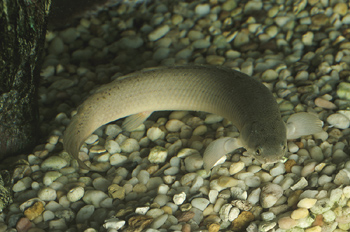|
Although they are called eels, they are more closely related to the catfish than to the common eels.
|
|
They live in shallow, muddy water and come to the surface every 10 minutes because they breathe atmospheric air.
|
|
Electric eels can reach 8 feet in length and weigh up to 44 pounds.
|
|
Their long and cylindrical body can be white, black, blue, purple or grey in color.
|
|
They are carnivores (meat-eaters) that eat other fish, amphibians, birds and small mammals.
|
|
Electric eels are solitary animals (live on their own). Group of eels is called swarm.
|
|
Electricity-producing organ takes 80% of their body. It is used both for defense against predators and for stunning of the prey.
|
|
Electric eel has around 6000 cells (known as electrocyte) that produce electricity. They can generate a power of 600 volts, which is 5 time stronger than the electricity generated in the standard US wall socket.
|
|
Electric eel can produce electric shock strong enough to knock down a horse.
|
|
Man can die if an eel hits him with several electric shocks. Luckily, humans don't come in contact with eels often.
|
|
20 foot long eel can produce enough electricity to light 12 light bulbs.
|
|
Since eels have poor eyesight, they generate low-level electric charge (up to 10 volts) that helps them see their surrounding and locate a prey.
|
|
Mating is happening during dry season. Male uses saliva to make a nest for eggs. Female can lay up to 17000 eggs. Both parents take care of their young.
|
|
Newly hatched eels eat small invertebrates but they also search nests of other eels and steal their eggs.
|
|
Electric eel lives around 15 years in the wild and up to 22 years in captivity.
|

 Electric eels are one of the 500 types of fish that are capable of producing electricity. They live in shallow, muddy areas of Amazon and Orinoco rivers in South America. They are not endangered.
Electric eels are one of the 500 types of fish that are capable of producing electricity. They live in shallow, muddy areas of Amazon and Orinoco rivers in South America. They are not endangered.